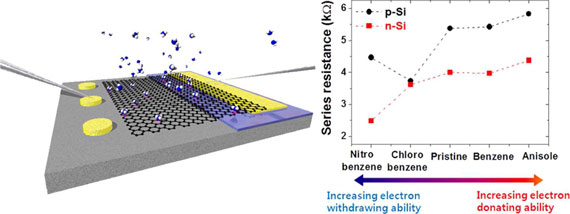| May 07, 2013 |
New graphene sensors could vastly improve air and water quality testing
|
|
(Nanowerk News) Researchers at CRANN, Ireland’s leading nanoscience institute, funded by Science Foundation Ireland and based at Trinity College Dublin, have discovered a new concept in sensor-development ("Chemically Modulated Graphene Diodes"). The research provides a completely new platform for the development of sensors worldwide and will lead to low-energy, remotely powered sensors that have greater detection capacity than those currently available.
|
|
Sensors receive and respond to signals when touched – either by physical or chemical matter. Everyday uses of sensors include in thermometers, medical devices such as pacemakers, in smoke alarms and intruder alarms, as well as in heat and air conditioning systems.
|
|
Prof. Georg Duesberg and his colleagues at CRANN have manufactured a sensor, composed of a single layer of graphene on a silicon surface. Graphene is a material with extraordinary properties that mean its use in sensors can detect even the slightest change in signal. It is a one-atom thick sheet of carbon, which is 200 times stronger than steel, but is incredibly conductive and extremely light.
|
 |
| The novel graphene diode sensors (GDS) are composed of monolayer graphene on silicon substrates, allowing exposure to liquids and gases. Parameter changes in the diode can be correlated with charge transfer from various adsorbates. The GDS allows for investigation and tuning of extrinsic doping of graphene with great reliability. The demonstrated recovery and long-term stability qualifies the GDS as a new platform for gas, environmental, and biocompatible sensors. (©ACS)
|
|
This new concept in sensor development will have commercial application in air quality control systems, particularly important in car manufacturing where the quality of the air is reduced through smog, exhaust fumes, odours and dust. The new air conditioning systems will react to the quality of the air – and adjust accordingly.
|
|
It could also lead to improved detection of bacteria and parasites such as cryptosporidium in drinking water supplies. In medicine, it could lead to the identification of bacteria in a patient’s exhaled air, meaning quicker, more accurate diagnosis of certain diseases.
|
|
Dr. Diarmuid O’Brien, Executive Director at CRANN said, “Everyday, CRANN researchers are discovering new concepts that have applications across a range of industries from medicine, to energy, pharmaceuticals and electronics among others. Nanoscience is leading to the products of the future, and CRANN’s researchers are having real impact helping to attract some of the world’s leading manufacturing companies to our shores. The discovery by Georg and his colleagues has already received interest from some leading car manufacturers and I look forward to seeing him bring his research to commercial application.”
|
|
Prof. Georg Duesberg said, “This discovery is one of the most exciting in sensor-development to date. It could lead to sensors that are much more functionally advanced, cost effective and energy efficient than those currently available and could vastly improve the monitoring of air and water quality.”
|
|
Prof. Georg Duesberg is one of CRANN’s 19 Principal Investigators. He specialises in fabricating carbon nanostructures, such as graphene and nanotubes for applications in ICT and renewable energy. Prof. Duesberg is one of the Irish researchers involved in the Graphene Flagship, an EU project investigating the commercial potential of graphene, worth €1 billion over 10 years.
|

